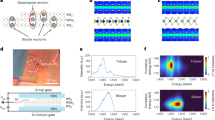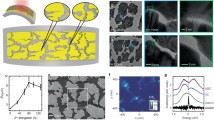Abstract
Two-dimensional (2D) crystals have renewed opportunities in design and assembly of artificial lattices without the constraints of epitaxy. However, the lack of thickness control in exfoliated van der Waals (vdW) layers prevents realization of repeat units with high fidelity. Recent availability of uniform, wafer-scale samples permits engineering of both electronic and optical dispersions in stacks of disparate 2D layers with multiple repeating units. Here we present optical dispersion engineering in a superlattice structure comprising alternating layers of 2D excitonic chalcogenides and dielectric insulators. By carefully designing the unit cell parameters, we demonstrate greater than 90% narrow band absorption in less than 4 nm of active layer excitonic absorber medium at room temperature, concurrently with enhanced photoluminescence in square-centimetre samples. These superlattices show evidence of strong light–matter coupling and exciton–polariton formation with geometry-tuneable coupling constants. Our results demonstrate proof of concept structures with engineered optical properties and pave the way for a broad class of scalable, designer optical metamaterials from atomically thin layers.
This is a preview of subscription content, access via your institution
Access options
Access Nature and 54 other Nature Portfolio journals
Get Nature+, our best-value online-access subscription
$29.99 / 30 days
cancel any time
Subscribe to this journal
Receive 12 print issues and online access
$259.00 per year
only $21.58 per issue
Buy this article
- Purchase on Springer Link
- Instant access to full article PDF
Prices may be subject to local taxes which are calculated during checkout





Similar content being viewed by others
Data availability
The data that support the conclusions of this study are available from the corresponding author on request.
Code availability
The TMM codes used in this study for plotting and modelling are available from the corresponding author on request.
References
Imamoto, H., Sato, F., Imanaka, K. & Shimura, M. AlGaAs/GaAs superlattice multi-quantum-well laser diode. Superlattices Microstruct. 5, 167–170 (1989).
Fox, M. & Ispasoiu, R. in Springer Handbook of Electronic and Photonic Materials (eds Kasap, S. & Capper, P.) 1021–1040 (Springer International Publishing, 2017).
Tredicucci, A., et al. Superlattice quantum cascade lasers. In Proc. In-Plane Semiconductor Lasers III, Optoelectronics ’99—Integrated Optoelectronic Devices, 23–29 January 1999, San Jose, CA, USA (Eds Choi, H. K. & Zory, P. S.) Vol. 3628 (SPIE, 1999).
Withers, F. et al. Light-emitting diodes by band-structure engineering in van der Waals heterostructures. Nat. Mater. 14, 301–306 (2015).
Ploog, K. Molecular beam epitaxy of semiconductor interfaces and quantum wells for advanced optoelectronic devices. Surf. Interface Anal. 12, 279–287 (1988).
Gil, B. & Aulombard, R.-L. (eds) Semiconductor Heteroepitaxy: Growth Characterization and Device Applications. Proc. International Conference on Semiconductor Heteroepitaxy, Montpellier, France, 4–7 July 1995 (World Scientific, 1996).
Lin, Z. et al. 2D materials advances: from large scale synthesis and controlled heterostructures to improved characterization techniques, defects and applications. 2D Mater. 3, 042001 (2016).
Zhao, W. et al. Evolution of electronic structure in atomically thin sheets of WS2 and WSe2. ACS Nano 7, 791–797 (2013).
Xu, M., Liang, T., Shi, M. & Chen, H. Graphene-like two-dimensional materials. Chem. Rev. 113, 3766–3798 (2013).
Briggs, N. et al. A roadmap for electronic grade 2D materials. 2D Mater. 6, 022001 (2019).
Wang, Q. H., Kalantar-Zadeh, K., Kis, A., Coleman, J. N. & Strano, M. S. Electronics and optoelectronics of two-dimensional transition metal dichalcogenides. Nat. Nanotechnol. 7, 699–712 (2012).
Jariwala, D., Marks, T. J. & Hersam, M. C. Mixed-dimensional van der Waals heterostructures. Nat. Mater. 16, 170–181 (2017).
Masubuchi, S. et al. Autonomous robotic searching and assembly of two-dimensional crystals to build van der Waals superlattices. Nat. Commun. 9, 1413 (2018).
Li, P. et al. Infrared hyperbolic metasurface based on nanostructured van der Waals materials. Science 359, 892–896 (2018).
Atwater, H. A. et al. Materials challenges for the Starshot lightsail. Nat. Mater. 17, 861–867 (2018).
Liu, X. et al. Strong light–matter coupling in two-dimensional atomic crystals. Nat. Photonics 9, 30–34 (2015).
Raja, A. et al. Coulomb engineering of the bandgap and excitons in two-dimensional materials. Nat. Commun. 8, 15251–15251 (2017).
Kang, K. et al. Layer-by-layer assembly of two-dimensional materials into wafer-scale heterostructures. Nature 550, 229–233 (2017).
Zhong, Y. et al. Wafer-scale synthesis of monolayer two-dimensional porphyrin polymers for hybrid superlattices. Science 366, 1379–1384 (2019).
Wang, S., Wang, X. & Warner, J. H. All chemical vapor deposition growth of MoS2:h-BN vertical van der Waals heterostructures. ACS Nano 9, 5246–5254 (2015).
Sun, Z. et al. Observation of the interlayer exciton gases in WSe2-p:WSe2 heterostructures. ACS Photonics 7, 1622–1627 (2020).
Fang, H. et al. Strong interlayer coupling in van der Waals heterostructures built from single-layer chalcogenides. Proc. Natl Acad. Sci. USA 111, 6198–6202 (2014).
Xu, W. et al. Controlling photoluminescence enhancement and energy transfer in WS2:hBN:WS2 vertical stacks by precise interlayer distances. Small 16, 1905985 (2020).
Xu, W. et al. Determining the optimized interlayer separation distance in vertical stacked 2D WS2:hBN:MoS2 heterostructures for exciton energy transfer. Small 14, 1703727 (2018).
Cadiz, F. et al. Excitonic linewidth approaching the homogeneous limit in MoS2-based van der Waals heterostructures. Phys. Rev. X 7, 021026 (2017).
Wierzbowski, J. et al. Direct exciton emission from atomically thin transition metal dichalcogenide heterostructures near the lifetime limit. Sci. Rep. 7, 12383 (2017).
Hu, F. et al. Imaging propagative exciton polaritons in atomically thin WSe2 waveguides. Phys. Rev. B. 100, 121301 (2019).
Gywat, O., Burkard, G. & Loss, D. Biexcitons in coupled quantum dots as a source of entangled photons. Phys. Rev. B. 65, 205329 (2002).
Chen, J. et al. Room temperature continuous-wave excited biexciton emission in perovskite nanoplatelets via plasmonic nonlinear fano resonance. Commun. Phys. 2, 80 (2019).
Moore, D. et al. Uncovering topographically hidden features in 2D MoSe2 with correlated potential and optical nanoprobes. npj 2D Mater. Appl. 4, 44 (2020).
Lee, C. et al. Anomalous lattice vibrations of single- and few-layer MoS2. ACS Nano 4, 2695–2700 (2010).
Alvertis, A. M. et al. First principles modeling of exciton-polaritons in polydiacetylene chains. J. Chem. Phys. 153, 084103 (2020).
Chubarov, M. et al. Wafer-scale epitaxial growth of unidirectional WS2 monolayers on sapphire. ACS Nano 15, 2532–2541 (2021).
Xiang, Y. et al. Monolayer MoS2 on sapphire: an azimuthal reflection high-energy electron diffraction perspective. 2D Mater. 8, 025003 (2020).
Pettersson, L. A. A., Roman, L. S. & Inganäs, O. Modeling photocurrent action spectra of photovoltaic devices based on organic thin films. J. Appl. Phys. 86, 487–496 (1999).
Burkhard, G. F. & Hoke, E. T. Transfer Matrix Optical Modeling (Stanford Univ., 2011).
Acknowledgements
D.J. acknowledges primary support for this work by the US Army Research Office under contract number W911NF-19-1-0109 and Air Force Office of Scientific Research (AFOSR) grant no. FA9550-21-1-0035. D.J. and J.L. also acknowledge partial support from grant nos. FA2386-20-1-4074 and FA2386-21-1-4063 and the University Research Foundation at Penn. D.J., E.A.S. and P.K. acknowledge support from the National Science Foundation (NSF) (grant no. DMR-1905853) and support from University of Pennsylvania Materials Research Science and Engineering Center (MRSEC) (grant no. DMR-1720530) in addition to usage of MRSEC supported facilities. The sample fabrication, assembly and characterization were carried out at the Singh Center for Nanotechnology at the University of Pennsylvania, which is supported by the NSF National Nanotechnology Coordinated Infrastructure Program grant no. NNCI-1542153. F.B. is supported by the Vagelos Integrated Program in Energy Research. H.Z. was supported by Vagelos Institute of Energy Science and Technology graduate fellowship. S.B.A acknowledges support from Swiss National Science Foundation Early Postdoc Mobility Program (P2ELP2_187977). A.R.D. acknowledges support of NG Next, UCLA Council on Research Faculty Research grant and the Hellman Foundation. The TMDC monolayer samples were provided by the 2D Crystal Consortium-Materials Innovation Platform (2DCC-MIP) facility at the Pennsylvania State University, which is funded by the NSF under cooperative agreement no. DMR-1539916. M.S. and N.R.G. acknowledge support from the Air Force Office of Scientific Research under award no. FA9550-19RYCOR050. This research used resources of the Center for Functional Nanomaterials, which is a US Department of Energy Office of Science User Facility, at Brookhaven National Laboratory under contract no. DE-SC0012704. We acknowledge helpful discussions on light coupling with M. W. Knight.
Author information
Authors and Affiliations
Contributions
D.J. and A.R.D. conceived the idea/concept. D.J. directed the collaboration and execution. F.B. and J.L. optimized the superlattice design computationally. P.K. reduced the design to experiments including performing all superlattice fabrication, mechanical exfoliated sample preparation, Cross-sectional TEM sample preparation with help of K.K., optical spectroscopy (including low temperature measurements) and electron microscopy characterization (aberration-corrected STEM and EDS imaging). J.L. with the help of H.L. and J.D. performed simulations and fitting of the experimental data to computational models. B.S. assisted with measurement, optimization and fitting of optical constants. H. Zhang and S.B.A. assisted in sample preparation and characterization, respectively. M.K. assisted with theoretical modelling and interpretation. H. Zhu, T.H.C. and J.M.R. synthesized MoS2 and WS2 samples used in Al2O3 spaced superlattices. C. McAleese, X.W., B.R.C. and O.W. led the synthesis of WS2 and h-BN used in the h-BN spaced superlattice samples. M.J.M., M.S., C.M. and N.J.G. synthesized and characterized the MoSe2 samples. E.A.S. supervised the electron microscopy experiments. P.K., J.L. and D.J. wrote the paper and all authors contributed to the writing and editing of the paper.
Corresponding authors
Ethics declarations
Competing interests
D.J., P.K., F.B., A.R.D., J.L. and E.A.S. have filed an invention disclosure based on this work. The authors declare no other competing interests.
Additional information
Peer review information Nature Nanotechnology thanks the anonymous reviewers for their contribution to the peer review of this work.
Publisher’s note Springer Nature remains neutral with regard to jurisdictional claims in published maps and institutional affiliations.
Supplementary information
Supplementary Information
Supplementary Information, Figs. 1–34 and Discussion.
Rights and permissions
About this article
Cite this article
Kumar, P., Lynch, J., Song, B. et al. Light–matter coupling in large-area van der Waals superlattices. Nat. Nanotechnol. 17, 182–189 (2022). https://doi.org/10.1038/s41565-021-01023-x
Received:
Accepted:
Published:
Issue Date:
DOI: https://doi.org/10.1038/s41565-021-01023-x
This article is cited by
-
Tailoring the dielectric screening in WS2–graphene heterostructures
npj 2D Materials and Applications (2023)
-
Photonic van der Waals integration from 2D materials to 3D nanomembranes
Nature Reviews Materials (2023)
-
Exciton polariton interactions in Van der Waals superlattices at room temperature
Nature Communications (2023)
-
A chemical-dedoping strategy to tailor electron density in molecular-intercalated bulk monolayer MoS2
Nature Synthesis (2023)
-
Moiré superlattice engineering of two-dimensional materials for electrocatalytic hydrogen evolution reaction
Nano Research (2023)



